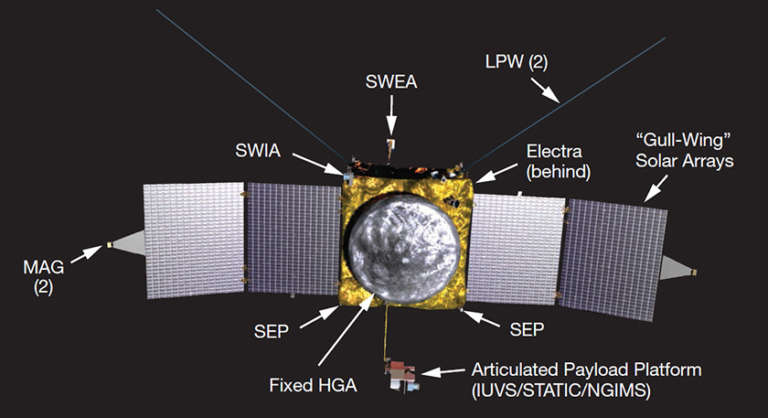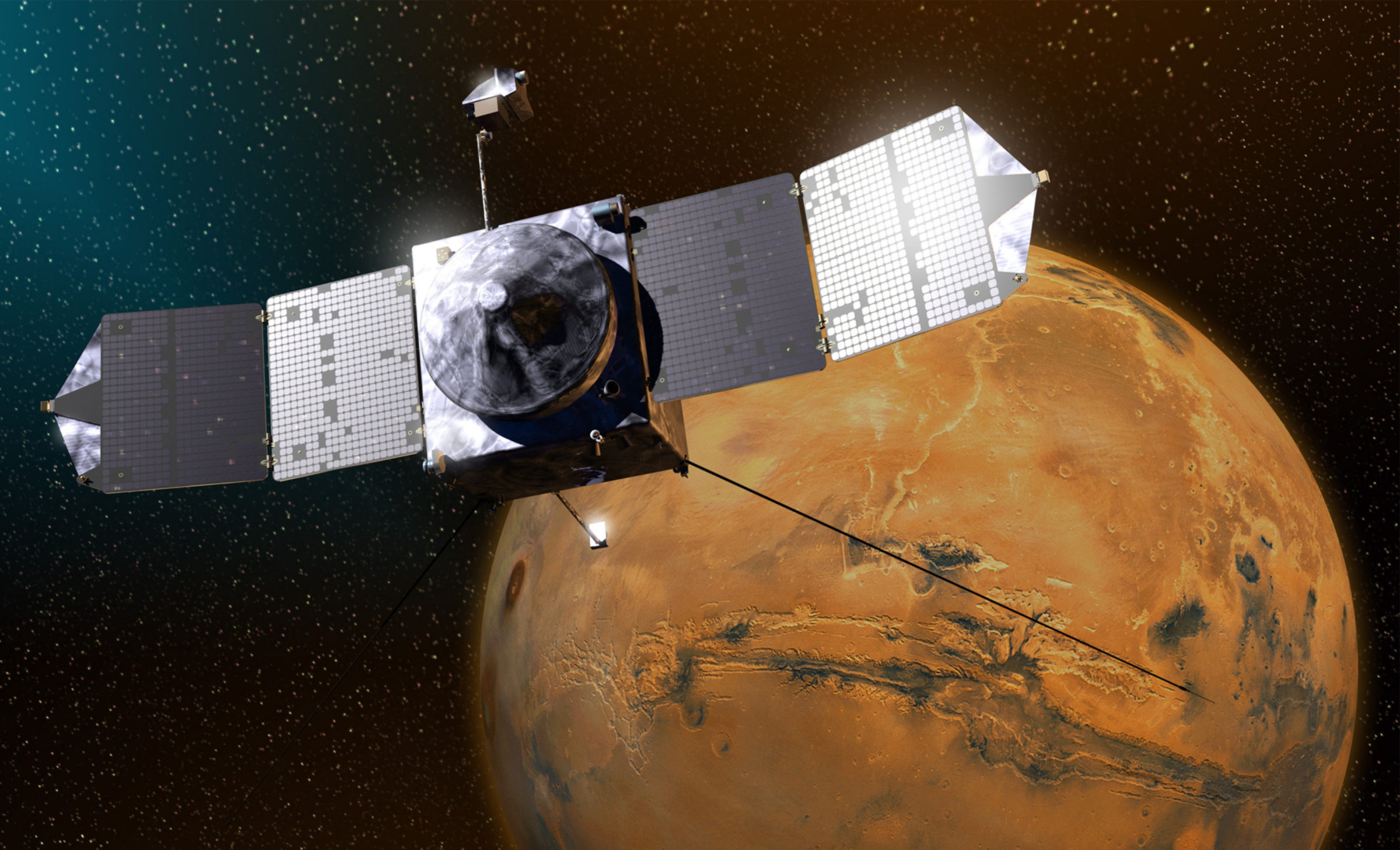Emily Lakdawalla • Nov 15, 2013
Answers to Frequently Asked Questions about MAVEN's launch and mission
MAVEN is just about to launch! The spacecraft is atop the rocket on the launch pad at Kennedy Space Center, Florida, and liftoff is currently scheduled for Monday, November 18, at 1:28 p.m. local time (10:28 PT / 18:28 UT). On Wednesday, the mission released their launch press kit. I've said it before and I'll say it again: before you ask anybody any questions about any NASA mission, look for the press kit. Odds are good your question is answered inside, in language you can understand. But in case you don't have time for that, this post paraphrases and summarizes the press kit's high points, and hopefully answers most of your questions.
Questions About Launch Day
What kind of rocket is it? It's an Atlas V-401. The "401" bit tells you the following: it's a 4-meter nosecone (the other common option is a 5-meter one). There are no extra solid rocket boosters strapped on to the sides. And there's one upper rocket stage, a Centaur. For comparison, Curiosity launched on an Atlas V-541 (5-meter fairing, 4 strap-on boosters, and a partridge in a pear tree, I mean a Centaur).
What's the launch timeline? If all goes well, the spacecraft will be on its own and on the way to Mars within an hour after launch. All times are Pacific/UT. Each launch day has a two-hour launch window, so these times may need to be adjusted if the spacecraft doesn't launch right when the window opens.
- 10:28/18:28: launch. The Atlas engine will burn for 4 minutes.
- 10:32/18:32: Atlas Booster Engine Cutoff (BECO)
- 6 seconds later, Centaur separation
- 10 seconds later, Centaur Main Engine Start (MES1). The Centaur engine will burn for 9 minutes.
- 8 seconds later, payload fairing jettison
- 10:42/18:42: Centaur First Main Engine Cutoff (MECO1). The spacecraft will coast for 28 minutes.
- 11:09/19:09: Centaur Second Main Engine Start (MES2). The Centaur engine will burn for 5 minutes.
- 11:15/19:15: Centaur Second Main Engine Cutoff (MECO2).
- 11:21/19:21: Spacecraft separation.
- 11:26/19:26: Establish communication through low-gain antenna and deploy solar panels. (Instrument booms will not be deployed until after Mars orbit insertion.)
- During a checkout phase lasting three months, they'll power on instruments and perform post-launch checkouts.
- The checkout phase will be completed when they activate the high-gain antenna.
- Orbit insertion takes place on or around September 22, 2014. It will go into an elliptical, 125 by 6,220 kilometer orbit. The apoapsis is about 250 kilometers above the orbit of Phobos.
What happens if they don't launch on Monday? The launch period lasts 20 days, and could even be extended out to December 23 if necessary.
For more specifics about the timeline of events on launch day, it's worth checking out the United Launch Alliance website and booklet on the MAVEN launch.
Questions about the spacecraft
What are its basic dimensions? Its body is a squat square box, 2.29 meters square and 1.5 meters high. The high-gain antenna is 2 meters in diameter (think about that; it's big). Its solar panels span a total of 11.43 meters and are in a "gull-wing" shape. When the spacecraft is all packed up for launch, with the solar panels folded, it's 3.47 meters high. Four instrument booms will extend outward from the bus: one for the SWEA instrument (1.65 meters long), one for the articulated payload platform (2.3 meters long), and two for the LPW instrument (7 meters long).
The launch mass is 2,454 kilograms, of which 1,645 kg is fuel and only 809 is spacecraft. Of that, the instrument package weighs in at 65 kilograms, and there's an additional 6.5 kilograms devoted to the Electra instrument that allows relay from rovers and landers to Earth.
Questions about the science
What is MAVEN's mission? The main questions MAVEN is seeking to answer is: how did Mars lose its early atmosphere, and how does atmospheric loss continue today? To do that, "MAVEN will study the boundary between the planet’s current atmosphere and outer space, measuring solar energy inputs to the atmosphere, the composition of the upper atmosphere, and the current rates of loss of atmospheric gas to space. Information about these escaping gases’ chemical, atomic and energetic character will inform scientists about the processes at work." The mission has three stated objectives:
- Determine the structure and composition of the Martian upper atmosphere today and understand the processes controlling them.
- Determine rates of loss of gas to space today and understand the processes that lead to escape.
- Measure properties and processes that will allow us to determine the integrated loss to space through time.
The mission is led by Principal Investigator Bruce Jakosky.

What science instruments are on MAVEN? There are eight instruments. Six of them are integrated into a "Particles and Fields package":
- Solar Energetic Particle (SEP) - two sensors, mounted on one corner of the spacecraft body. It will measure hydrogen and helium emitted by the Sun during storms, flares, and coronal mass ejections. Predecessors flew to space on THEMIS (now ARTEMIS) and Wind. SEP is led by Davin Larson.
- Solar Wind Ion Analyzer (SWIA) - one sensor, mounted on one corner of the spacecraft body. It will measure the density, temperature, and velocity of solar wind ions. Predecessors flew on FAST, Wind, and THEMIS (now ARTEMIS). Jasper Halekas leads SWIA and is also involved on similar investigations on ARTEMIS and LADEE.
- Solar Wind Electron Analyzer (SWEA) - mounted on a 1.65-meter-long boom. It measures the energy and angular distributions of electrons flowing along magnetic fields. It is led by David Mitchell.
- SupraThermal and Thermal Ion Composition (STATIC) - mounted on the articulated payload platform with IUVS and NGIMS. It will measure the composition and velocity of high-energy ions of hydrogen, helium, oxygen, and carbon dioxide ions in Mars' atmosphere. A predecessor flew on Cluster. STATIC is led by Jim McFadden.
- Langmuir Probe and Waves (LPW) - two 7-meter-long booms. It will measure the density of the ionosphere and the temperature of ionispheric electrons. Predecessors flew on STEREO and THEMIS (now ARTEMIS). There are two booms so that the spacecraft's wake obscures no more than one sensor at a time. LPW is led by Robert Ergun. LPW also has an extreme ultraviolet detector, led by Frank Eparvier.
- Magnetometer (MAG) - two sensors, mounted on the tips of the solar panels, provide contextual information on the magnetic field for the other instruments. Magnetometers have flown on many missions -- the heritage for this one goes back to Voyager. MAG is led by Jack Connerney.
Two more instrument packages are on the articulated payload platform, which continuously rotates as MAVEN orbits in order to keep the instruments pointed correctly at all times -- except for a five-hour period twice each week when the spacecraft turns to Earth to relay data through its high-gain antenna.
The Remote Sensing package contains one instrument, the Imaging UltraViolet Spectrograph (IUVS). It will study Mars' atmospheric composition from afar, looking across the limb while close to Mars and imaging the whole disk when far from Mars. It will also observe the occultation of stars by the atmosphere to measure carbon dioxide abundance. Many missions have flown similar instruments, including UVIS on Cassini at Saturn. IUVS is co-led by Nick Schneider and Bill McClintock.
The Neutral Gas and Ion Mass Spectrometer (NGIMS) is also its own instrument package. It will measure the composition of neutral gases and ions in the upper atmosphere, including helium, nitrogen, oxygen, carbon monoxide, argon, and carbon dioxide. It will also measure the isotopic ratios for carbon, nitogen, oxygen, and argon. NGIMS will be able to gather data at altitudes of 125 to 400 kilometers. MAVEN will spend 12 minutes at those altitudes on each orbit. NGIMS is led by Paul Mahaffy, who also leads the mass spectrometer instrument on Curiosity (SAM).
Isn't there a camera? No.
What can MAVEN tell us about methane on Mars? None of MAVEN's instruments can measure methane in Mars' atmosphere. That's up to India's Mars Orbiter Mission and ESA's future ExoMars Trace Gas Orbiter.
If your curiosity about MAVEN still isn't satisfied, read the rest of the launch press kit for yourself!


 Explore Worlds
Explore Worlds Find Life
Find Life Defend Earth
Defend Earth



